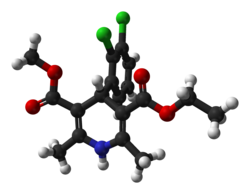Interactions
Felodipine is metabolized by cytochrome P450 3A4, so substances that inhibit or activate CYP3A4 can strongly effect how much felodipine is present. [1]
CYP3A4 inhibitors, which increase the amount of felodipine available per dose, include cimetidine, erythromycin, itraconazole, ketoconazole, HIV protease inhibitors, and grapefruit juice. [1] [4]
CYP3A4 activators, which decrease the amount of felodipine available per dose, include phenytoin, carbamazepine, rifampicin, barbiturates, efavirenz, nevirapine, and Saint John's wort. [1]
History
The Swedish company Hässle, a division of Astra AB, discovered felodipine; [7] it filed a patent application in 1979 claiming felodipine as an antihypertensive drug. [8] [9] Astra partnered this drug and others with Merck & Co. in the US under a 1982 agreement between the companies. [7] The drug was approved by the FDA in 1991 after a three-and-a-half-year review; the drug entered a very crowded market to included the other calcium channel blockers nifedipine, verapamil, nicardipine, and isradipine. [7] The FDA gave the drug a 1C rating, meaning that it found little difference between felodipine and the drugs already approved for the same use. [7]
In 1994 Astra AB and Merck changed their partnership to a joint venture called Astra Merck, [10] and in 1998 Astra (by that time, AstraZeneca) bought out Merck's rights in the joint venture. [11]
The first generics became available in Sweden in 2003 [12] and in the US in 2004. [13] : 155
In April 2016, AstraZeneca announced that they were selling the right to market felodipine in China to China Medical System Holdings for $310 million; AZ would continue to manufacture the drug. [14]
Society and culture
As of 2016, felodipine was marketed under many brand names worldwide: Auronal, Cardioplen, Catrazil, Dewei, Dilahex, Enfelo, Erding, Fedil, Fedisyn, Feldil, Felicipin, Felo, Felocard, Felocor, Feloday, Felodil, Felodin, Felodip, Felodipin, Felodipina, Felodipine, Felodipino, Felodistad, Felogard, Felohexal, Felop, Felopine, Felostad, Feloten, Felotens, Felpin, Flodicar, Flodil, Keliping, Keydipin, Lodistad, Modip, Munobal, Nirmadil, Parmid, Penedil, Perfudal, Phelop, Phenodical, Plendil, Plentopine, Polo, Presid, Preslow, Prevex, Renedil, Sistar, Splendil, Stapin, Topidil, Vascalpha, Versant, and XiaoDing. [15]
The combination of felodipine and candesartan was marketed as Atacand. [15]
The combination of felodipine and ramipril was marketed as Delmuno, Tazko, Triacor, Triapin, Triasyn, Tri-Plen, Unimax, and Unitens. [15]
The combination of felodipine and enalapril was marketed as Lexxel. [15]
The combination of felodipine and metoprolol was marketed as Logimat, Logimax, and Mobloc. [15]

